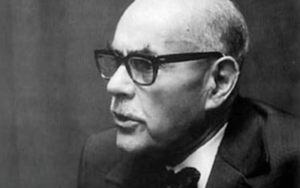Wilfred Bion: Biography and Most Relevant Works

Wilfred Bion was born in Mathura on September 8, 1897, and died in Oxford on August 28, 1979. He studied medicine but, in practice, he decided to focus on psychoanalysis. His main contribution was the theory about the way human beings think.
Bion stood out for his work as a psychoanalyst on patients with psychotic disorders. At first, it was based on Melanie Klein and Sigmund Freud’s studies. Later, he created his own theories and even expanded concepts that Klein had previously established.
In addition, his work with World War II soldiers was the foundation of one of his main contributions, relevant to the framework of group psychology. Read on to find out why Bion is one of the most important figures in the history of psychoanalysis.
“The purest form of listening is to listen without memory or desire.”
-Wilfred Bion-
Wilfred Bion’s life
Bion was born and lived in India until the age of eight. He grew up in a wealthy family, whose main income came from the colonization of land under the rule of the British Empire.
Later, his parents sent him to boarding school in England, where he stood out for being a great athlete, especially in swimming and water polo. Throughout his career, Bion had always been open about his time at the boarding school and about how much he missed his parents and India.
Bion participated in both world wars. In fact, he was a volunteer in World War I and was awarded both a decoration for distinguished services and the French Légion d’honneur. Then, during WWII, he worked as a military psychiatrist at the Northfield Hospital.
During his work as a psychiatrist, he delved into Melanie Klein’s theories and that of other prestigious psychoanalysts. In fact, he also worked with Donald Winnicott and Herbert Rosenfeld (a student of Kelin’s) since he was working at the Tavistock Clinic.
Bion’s work was so important that he became president of the British Psychoanalytic Association. In his last years, he worked in California to divulge his psychosis treatment theories.

Wilfred Bion and his theory of thinking
Wilfred Bion suggested that humans have an innate tendency to know about the world. It’s the spark that lights the fuse of curiosity and encourages an individual to learn new things, both from themselves and from the world.
According to Bion, a thought is transformed gradually into a thinking machine, thanks to the accumulation of perceptions, feelings, and experiences. This is called the “container-contained” relationship between thinking and communicating. A baby, for example, experiences sensations and emotions that they can’t tolerate and, therefore, reject. The mother (or whoever fulfills a similar role), takes those emotions and works them up in a way that the baby can handle or understand.
Then, the baby internalizes those thoughts and forms their own thinking system. Finally, they’ll be able to form their own opinions and give meaning to what they experienced. According to Bion, this is the engine of psychological development.
However, the primitive elements will stay deeply rooted if the baby or the mother isn’t able to give meaning to certain events, due to the anguish that this “gap” produces. And this anguish then manifests as hallucinations, somatizations, and other potential symptoms related to it.
In this case, the therapist’s role would be that of the container, because they collect the patient’s anguish. This way, the patient’s psychic structure needs support to be able to work on its rooted primitive issues, and the therapist is the facilitator that makes that possible.
Bion’s most relevant work
Wilfred Bion wrote two works that are highly relevant, both for what they represent in his thinking theory and for what they’ve meant for psychoanalysis’ evolution. These were:
- Group experience. This work is a new contribution to the conception of groups from a psychoanalytic perspective. It presents Kleinian concepts such as the defense mechanism of projective identification. Also, it focuses on what patients say or don’t say during therapy, including silences, which allows an understanding of behaviors that are apparently difficult to decipher during a session. Also, it talks about the concept of group mentality.
- Learning from experience. In this book, Wilfred Bion focuses on experience and learning, and related problems. He suggests in this work that knowing causes suffering, due to the emotional experience it entails. He makes a reflection on the importance of restructuring ideas about the origin and the nature of thinking. Furthermore, he explores the thinking process in psychotic patients based on his experience and from the psychoanalysis standpoint.
In this last book, he explains his original thinking theory. In the beginning, he talks about how psychotic patients form thoughts. For that, he explores his own past works and he even criticizes it, which goes to show the limitations the analyst may have had in the past.

To speak of Bion is to speak of an author who, with the originality and depth of his studies, managed to give psychoanalysis a new perspective. Today, a growing number of analysts, psychologists, and psychiatrists find his legacy incredibly important. Thus, his contributions continue to be a reference in the field he elaborated them in.
All cited sources were thoroughly reviewed by our team to ensure their quality, reliability, currency, and validity. The bibliography of this article was considered reliable and of academic or scientific accuracy.
- Bion, W.R. (1966). Aprendiendo de la experiencia. Paidós.
- Bion, W.R. (1990). Experiencias en grupos. Paidós.
- Bion W. R. (1996). Volviendo a pensar. Horné.
- Bléandonu, G. & Pajackowska, C.T. (1994). Wilfred Bion. His life and works 1897-1979. Guilford Press.
This text is provided for informational purposes only and does not replace consultation with a professional. If in doubt, consult your specialist.








